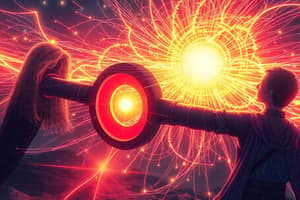Podcast
Questions and Answers
What is a characteristic of magnetic force?
What is a characteristic of magnetic force?
- It requires contact to activate.
- It is stronger when objects touch.
- It can be felt only at a distance of one meter.
- It is a non-contact force. (correct)
Magnetic field lines can cross each other.
Magnetic field lines can cross each other.
False (B)
What are the two common methods to detect a magnetic field?
What are the two common methods to detect a magnetic field?
Using a compass or iron filings.
The magnetic field lines point from the __________ pole to the __________ pole.
The magnetic field lines point from the __________ pole to the __________ pole.
Where is the magnetic force the strongest?
Where is the magnetic force the strongest?
Match the following uses of magnets with their applications:
Match the following uses of magnets with their applications:
Field lines lead from one magnet to another when they repel each other.
Field lines lead from one magnet to another when they repel each other.
What indicates the strength of a magnetic field?
What indicates the strength of a magnetic field?
What is the definition of a magnetic field?
What is the definition of a magnetic field?
Like poles of two magnets attract each other.
Like poles of two magnets attract each other.
Name two materials that are magnetic.
Name two materials that are magnetic.
A bar magnet has a ______ pole and a ______ pole.
A bar magnet has a ______ pole and a ______ pole.
What happens when two bar magnets are brought together with like poles facing each other?
What happens when two bar magnets are brought together with like poles facing each other?
Match the following terms with their definitions:
Match the following terms with their definitions:
Paper clips not in a magnetic field will be attracted to a magnet.
Paper clips not in a magnetic field will be attracted to a magnet.
How can you detect a magnetic field?
How can you detect a magnetic field?
What is the primary component of a compass that helps indicate direction?
What is the primary component of a compass that helps indicate direction?
Iron, nickel, and cobalt do not exhibit magnetic properties until they are magnetised.
Iron, nickel, and cobalt do not exhibit magnetic properties until they are magnetised.
What happens when the domains in a magnetic material are aligned?
What happens when the domains in a magnetic material are aligned?
The ________ pole of the compass needle points toward the Earth's north pole.
The ________ pole of the compass needle points toward the Earth's north pole.
Match the terms with their definitions:
Match the terms with their definitions:
To magnetise a piece of iron, you should rub the north pole of a magnet from which part of the metal?
To magnetise a piece of iron, you should rub the north pole of a magnet from which part of the metal?
A compass can be used for navigation without a map.
A compass can be used for navigation without a map.
How can you detect a magnetic field?
How can you detect a magnetic field?
Flashcards are hidden until you start studying
Study Notes
Magnetic Force
- Magnetic force is a non-contact force, meaning magnets can affect materials without direct contact.
Detecting Magnetic Fields
- A compass can be used to detect a magnetic field as its needle aligns with the magnetic direction.
- Iron filings can visually reveal the configuration of a magnetic field when sprinkled around a magnet.
Magnetic Field Lines
- Magnetic field lines do not cross each other, indicating the direction and strength of the field.
- Field lines extend from the north pole to the south pole of a magnet.
- Closer field lines indicate a stronger magnetic force, which is most intense near the poles.
- Each field line is continuous and has an arrowhead showing direction.
- Field lines concentrate at the poles, illustrating magnetic strength.
Interaction of Two Magnets
- Field lines demonstrate attraction when two magnets are brought together: they connect from one magnet's north pole to the other's south pole.
- Magnets repel each other when like poles face each other, with no connecting field lines.
Characteristics of Magnetic Materials
- Only a few materials are magnetic, including iron, cobalt, nickel, and steel.
- Magnets can be permanent, like bar magnets, which have a constant magnetic field.
Magnetism Principles
- Opposite poles of magnets attract, while similar poles repel.
- Paper clips only attract to a magnet when within its magnetic field.
Understanding Magnetic Fields
- A magnetic field is the area surrounding a magnet where its effects can be experienced, even if it's not visible.
- The north pole of a compass needle points towards the Earth's magnetic north, aiding navigation.
How to Magnetize Iron
- Iron, nickel, and cobalt can exhibit magnetic properties when magnetized.
- To magnetize iron, rub the north pole of a magnet from the center to the end of the metal repeatedly with firm pressure.
- Testing for magnetism determines if the process was successful.
Domains in Magnetic Materials
- Magnetic domains in materials behave like tiny magnets.
- Randomly arranged domains do not exhibit magnetism, while aligned domains result in a magnetized material capable of attracting other magnetic objects.
Studying That Suits You
Use AI to generate personalized quizzes and flashcards to suit your learning preferences.




